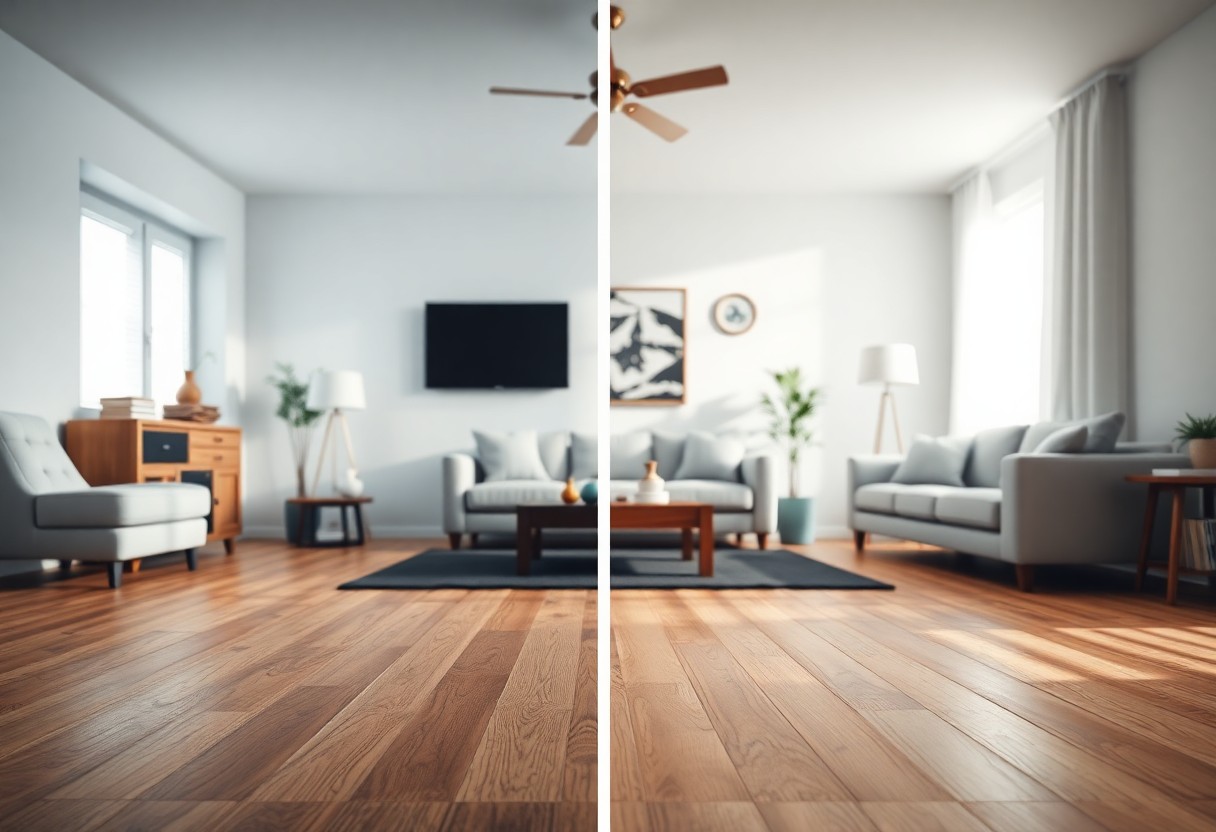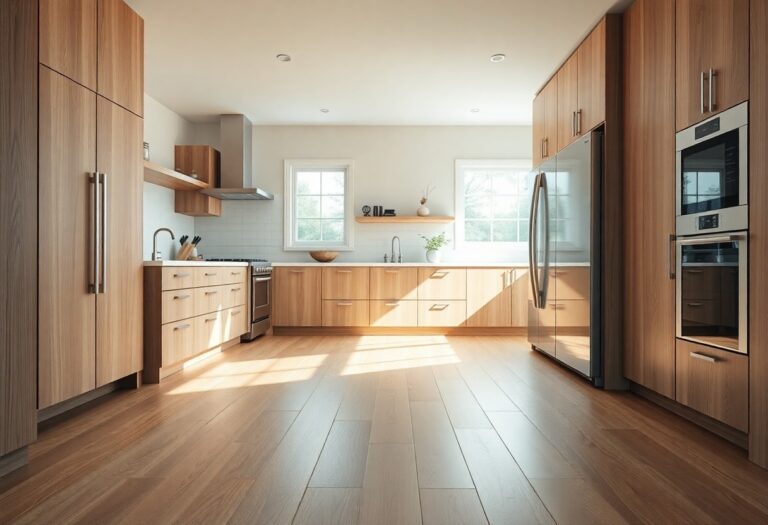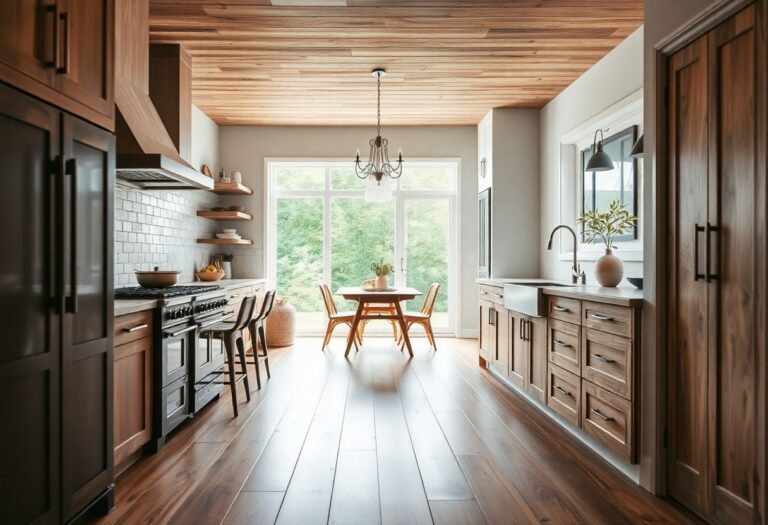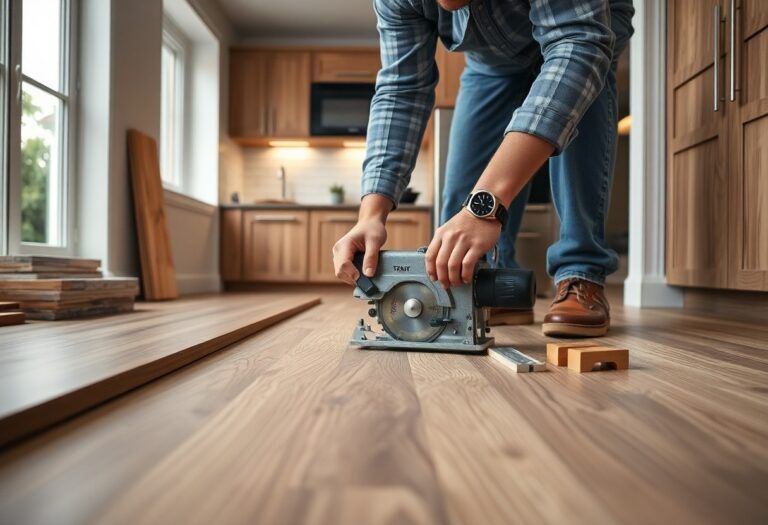Many homeowners face the dilemma of choosing between pre-engineered hardwood and laminate flooring when updating their spaces. Each option offers distinct benefits, so understanding the differences can help you make an informed decision based on your lifestyle, budget, and aesthetic preferences. In this post, we’ll explore the characteristics, advantages, and drawbacks of both flooring types, empowering you to select the right fit for your home.
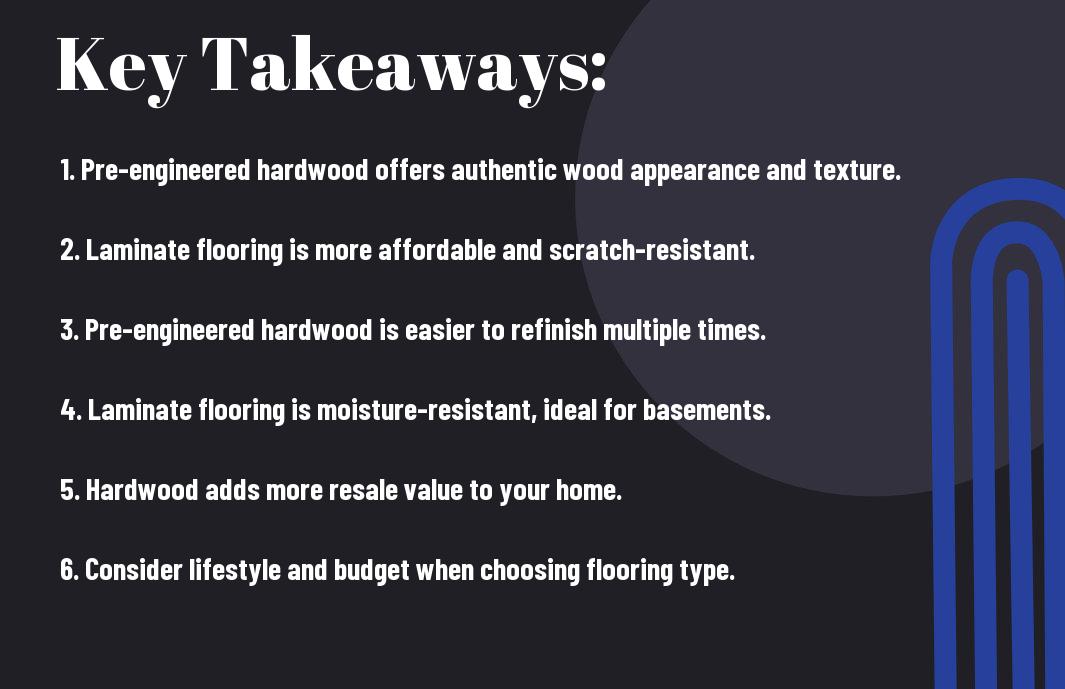
Overview of Pre-Engineered Hardwood
To enhance your living space with the elegance of wood without compromising durability, pre-engineered hardwood is an excellent choice. This flooring option combines natural wood with advanced technology for a product that stands the test of time while offering aesthetic appeal. Suited for various spaces in your home, pre-engineered hardwood can give you the warmth of traditional hardwood flooring with added resilience against moisture and temperature fluctuations.
Composition and Construction
Before making a decision, it’s vital to understand the makeup of pre-engineered hardwood. This flooring consists of multiple layers, with a top layer of genuine hardwood veneer bonded to a core of plywood or high-density fiberboard. This construction not only gives you the appearance of solid wood but also makes the flooring more stable and less prone to warping or cracking.
Advantages of Pre-Engineered Hardwood
Behind the appealing look of pre-engineered hardwood lies a number of advantages worth considering for your home. Its innovative design offers enhanced durability and stability, making it suitable for various environments. Whether you are considering it for rooms with fluctuating humidity or for installations over radiant heating, pre-engineered hardwood can meet your needs with style and functionality.
Also, pre-engineered hardwood is easier to install than traditional solid hardwood, thanks to its click-lock design or glue-down options. This feature allows you to potentially save on installation costs and time, letting you enjoy your new flooring sooner. Additionally, it can be refinished, albeit less frequently than solid wood, which provides you with the opportunity to refresh its appearance without a complete replacement. By choosing pre-engineered hardwood, you not only invest in a beautiful flooring solution but also in lasting performance and flexibility for your home.
Overview of Laminate Flooring
It is crucial to understand that laminate flooring is a popular choice among homeowners, providing a stylish yet practical flooring solution. Made to mimic the appearance of wood, stone, or tile, laminate consists of layered materials that create a durable and cost-effective option for any space in your home.
Composition and Construction
Among its layers, laminate flooring typically features a core made from high-density fiberboard, topped with a photographic layer that replicates various natural materials. The final layer is a clear protective coating that enhances durability and resistance to scratches, stains, and fading.
Advantages of Laminate Flooring
Behind its appealing aesthetics lies an array of benefits that make laminate flooring an excellent choice for your home. With its affordability, easy installation, and low maintenance requirements, laminate offers you a practical and versatile flooring solution that can suit various styles and functions.
Understanding the advantages of laminate flooring can significantly influence your decision. Not only does it provide a beautiful look at an affordable price, but its resilience and ease of installation make it perfect for busy households. Additionally, laminate flooring is resistant to moisture, making it an excellent option for kitchens and bathrooms. You will appreciate its low maintenance, as regular sweeping and occasional mopping will keep your floors looking like new for years to come.
Key Differences Between Pre-Engineered Hardwood and Laminate
All flooring options have unique characteristics that can affect your choice. Pre-engineered hardwood is made from real wood, providing an authentic look and feel, while laminate consists of a high-density fiberboard core beneath a photographic layer that mimics wood. The surface durability, maintenance needs, and installation methods also vary significantly between these two types of flooring, making it important to weigh your preferences and lifestyle against their features.
Durability and Longevity
One of the main factors to consider is the durability and longevity of each option. Pre-engineered hardwood can last decades with proper care and can be refinished, whereas laminate has a shorter lifespan and is less resistant to damage from moisture and heavy traffic. Your lifestyle and expected wear should influence your choice.
Cost Comparison
Against the backdrop of flooring options, understanding the cost is vital. Here’s a quick look at how pre-engineered hardwood and laminate price out:
| Type | Estimated Cost per Square Foot |
|---|---|
| Pre-Engineered Hardwood | $5 to $12 |
| Laminate | $1 to $5 |
Cost impacts your flooring decision significantly. Pre-engineered hardwood typically has a higher upfront cost but may offer better long-term value due to its longevity and refinishing options. Conversely, laminate is budget-friendly, catering to homeowners looking for quick and economical renovations. Weighing initial investment against expected lifespan will guide you in choosing the best flooring for your space.
| Consideration | Details |
|---|---|
| Installation Cost | Pre-engineered hardwood may require professional installation, while laminate can often be a DIY project, reducing labor costs. |
| Maintenance | Future expenses for upkeep differ, as hardwood needs occasional refinishing, whereas laminate just requires basic cleaning. |
Aesthetic Considerations
Not all flooring options are created equal when it comes to visuals. The look and feel of your flooring can significantly influence the overall ambiance of your home. You might prefer the authentic warmth and texture of pre-engineered hardwood, which offers a natural beauty. In contrast, laminate flooring can mimic various styles at a lower cost, providing versatility and a modern look tailored to your tastes.
Look and Feel
Considerations for the look and feel of your flooring often revolve around the texture, warmth, and luxury that each material provides. Pre-engineered hardwood feels rich and organic underfoot, while laminate may provide a smoother, more uniform surface. The choice impacts not just aesthetics, but also the comfort and vibe of your living space.
Available Styles and Finishes
Around various styles and finishes, both pre-engineered hardwood and laminate flooring can present numerous options. While pre-engineered hardwood often comes in classic wood varieties with various stains, laminate offers an extensive range of patterns and colors that can resemble different materials, including tile and stone.
Feel free to explore the numerous styles and finishes available for each type of flooring. Pre-engineered hardwood typically showcases timeless patterns and rich wood tones that elevate the aesthetic of traditional homes. On the other hand, laminate flooring comes in a vast array of trendy colors and styles, allowing you to create a modern or eclectic space without overspending. Consider your personal style preferences and how each option complements your home décor to make the best choice for your living environment.
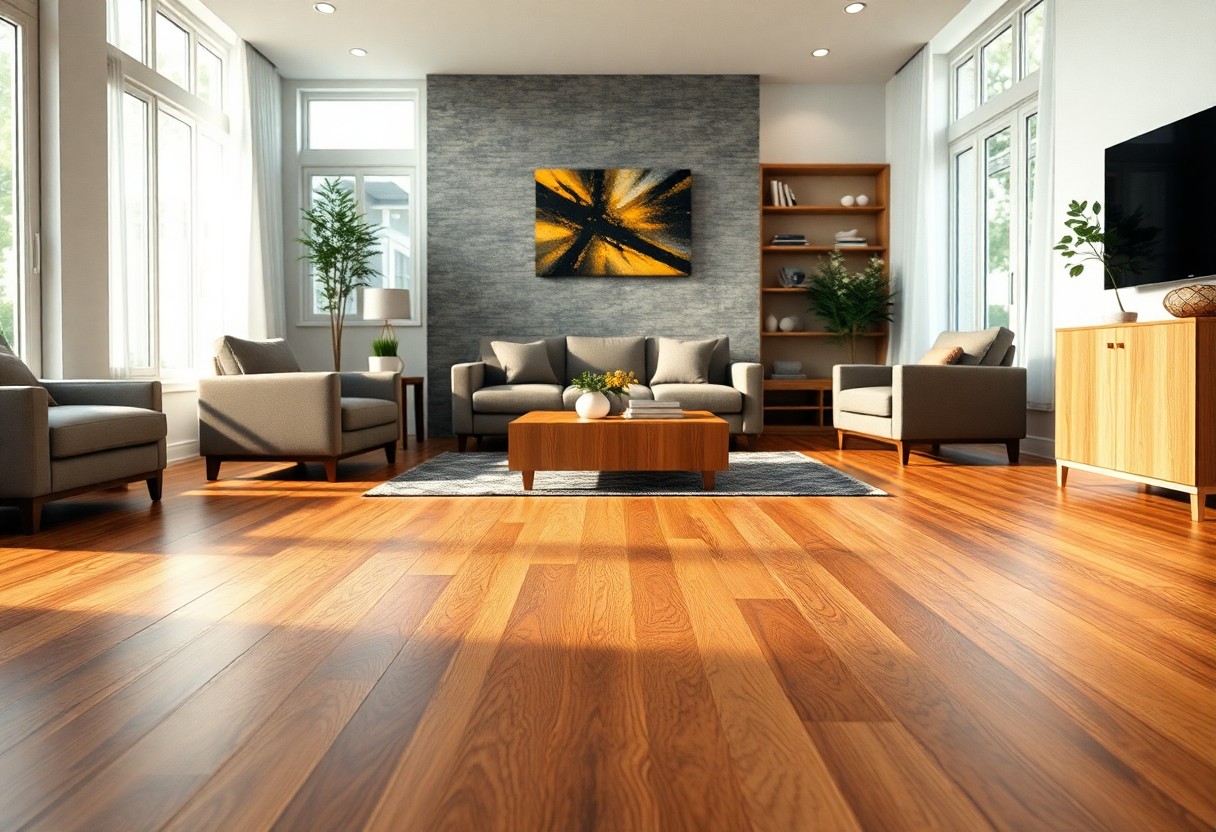
Installation and Maintenance
For homeowners, understanding the installation and maintenance requirements of flooring options can significantly impact your decision. Pre-engineered hardwood and laminate flooring have different installation techniques and upkeep guidelines that can affect how well they perform in your space over time.
Installation Processes
Installation of pre-engineered hardwood typically involves nailing, gluing, or floating the planks, depending on the type you choose. Laminate flooring, on the other hand, usually features a click-lock system, allowing for a straightforward DIY installation. Both options are user-friendly, but if you’re not confident, hiring a professional can ensure a seamless finish.
Maintenance Requirements
The maintenance of your flooring is crucial for longevity and appearance. Pre-engineered hardwood requires periodic refinishing and special cleaning products to prevent scratches and preserve its natural beauty. Laminate, however, is generally more resistant to moisture and stains but should still be cleaned regularly to maintain clarity and texture.
Plus, laminate flooring’s low-maintenance nature makes it appealing for busy households. Just a quick sweep or vacuum and occasional damp mopping with a manufacturer-recommended cleaner can keep it looking great. Conversely, you’ll want to use a gentler approach with pre-engineered hardwood, avoiding excessive moisture and harsh chemicals to enhance its lifespan.
Environmental Impact
Now, when considering flooring for your home, it’s imperative to assess the environmental impact of both pre-engineered hardwood and laminate options. Each material has distinct characteristics that can influence not only your living space but also the planet. Understanding how these choices affect ecosystems, emissions, and sustainability can guide you towards a more environmentally conscious decision.
Sourcing and Sustainability
Along with the aesthetic appeal, the sourcing of materials plays a significant role in environmental sustainability. Pre-engineered hardwood often utilizes timber from responsibly managed forests, which helps maintain ecological balance. In contrast, laminate flooring is typically made from composite materials and can involve less sustainable practices, making your selection crucial in terms of sourcing and long-term sustainability.
Recyclability
Below, the recyclability of flooring materials is an important factor that can affect your choice. Pre-engineered hardwood, being a natural product, can often be repurposed or recycled into new applications, while laminate flooring generally has more limited recycling options due to its layered composition. When you think about the end-of-life options for your flooring, it can influence the overall environmental footprint.
Understanding the recyclability of these flooring choices helps you make informed decisions for your home. Many pre-engineered hardwood products can be reused or downcycled, offering a sustainable path when it’s time for replacement. Laminate flooring, however, often ends up in landfills, as its mixed materials complicate recycling efforts. By choosing flooring with better recyclability, you align your home improvement projects with eco-friendly practices, aiding in reducing waste and promoting sustainability.
Summing up
The choice between pre-engineered hardwood and laminate flooring ultimately depends on your specific needs and lifestyle. If you prioritize authenticity and longevity, pre-engineered hardwood may be the better investment for your home. However, if budget constraints and ease of maintenance are more important, laminate flooring can offer a cost-effective and stylish alternative. Consider your living space, foot traffic, and aesthetic preferences to make an informed decision that enhances your home’s value and comfort.


